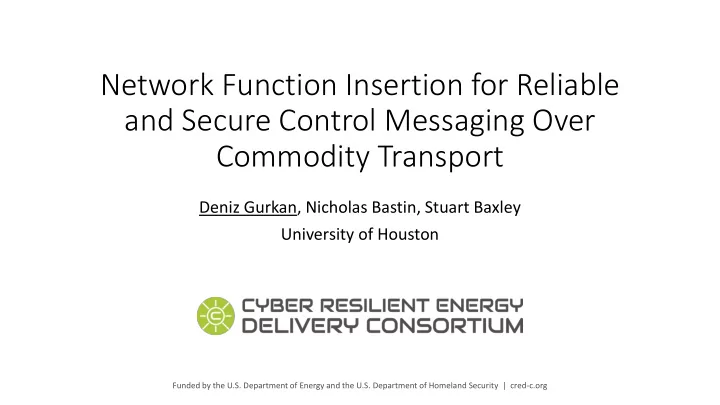

Network Function Insertion for Reliable and Secure Control Messaging Over Commodity Transport Deniz Gurkan, Nicholas Bastin, Stuart Baxley University of Houston Funded by the U.S. Department of Energy and the U.S. Department of Homeland Security | cred-c.org
Resiliency against Threat Vectors in Commodity Transport • Sensor data and control directives from oil/gas production facilities are transmitted unencrypted using unreliable transport protocols over lossy network infrastructures • Network threats evolve on a time scale significantly faster than the upgrade schedules of industrial equipment
Resiliency Solution: Network Function Insertion • Decouple the implementation of secure, reliable transport from the actual industrial hardware • Provide agility in responding to new threats without downtime or vendor upgrades • Design and implement a network function which can be deployed without infrastructure disruption into existing ICS
Resiliency through Policy Enforcement • Network transport quality • Loss • Delay • Re-ordering • Threat vectors: injection attacks • Signed packets: Integrity of the system – system control data: • Injection by an external third party • Injection by an internal third party • Encryption: Privacy – system sensor data: • Listening by a third party
POLICY: control knobs with trade-off • A lossy network: P2 P1
POLICY: control knobs with trade-off • A lossy network: Existing protocols: retransmissions, lost connections, end point ( not flow-specific ) tuning P1 P3 P2 Custom POLICY: delayed but GUARANTEED delivery Custom POLICY: NO delivery unless IN-ORDER
Resiliency – Network Transport Quality • Loss, delay, re-ordering
POLICY: control knobs with trade-off • A lossy network: P3 P3 P2 P2 P2 P1 P1 P3 P2 P1 ACK RESEND P2 Custom POLICY: GUARANTEED delivery – delayed on lost packets
Resiliency – Attack Vectors: injections • Integrity of the system (system control/sensor data), privacy (sensor data)
Resiliency against attacks Existing protocols: end to end protection with firewalls, without signed packets per flow injecting P3 third party injecting P3 third party P1 P2 P2 P1 listening listening third party third party external third party sensor site internal third party
POLICY: guarantee access by authorized personnel and keep sensor/control data private Custom POLICY: signed and encrypted packets of the flow injecting P3 third party P1 P1 P1 injecting P3 third party listening listening third party third party external third party sensor site internal third party
Reconfigurable ICS Scenario on UH Testbed • Support multiple concurrent arbitrary isolated topologies, with MTS (Managed Topology Services) orchestration system: • Software-defined networking scenarios • Critical infrastructure security • Internet of things • Computer networking education • UH Testbed Resources: • Over 1000 1Gb and 10Gb switch ports from Brocade, Cisco, Dell/Force10, HP, Intel, and Pica8 • Over a dozen SDN switches • A variety of specialized forwarding devices (NPUs, hybrid server-switches, etc.) from Caros, Cavium, Freescale, Intel, and Znyx • Over 250 general purpose CPU cores and 1.5TB of ram across two dozen servers • Over 100TB of raw storage capacity and 24 line-rate taps
Network Function Insertion: Testbed Setup • Number of sites • Sensors per site • Sensor emulation software at sensor nodes • Management emulation software at remote console • Loss • Delay • Reorder • Without a NF - baseline behavior of the network • With NF - network function software at NF nodes
Project Next Steps • Reference implementation that achieves representative ICS scenarios with configurable loss and delay. • A test suite for the reference implementation using the UH Testbed. • A specification document for the network function deployment and logical functionality. • Analysis to show the level of resiliency achieved through the network function deployment. • Validation and verification results of our implementation and testbed setup in collaboration with PNNL.
http://cred-c.org @credcresearch facebook.com/credcresearch/ Funded by the U.S. Department of Energy and the U.S. Department of Homeland Security
Recommend
More recommend